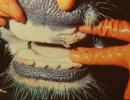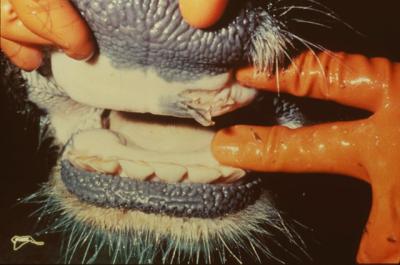
|
Foot and Mouth Diseases (FMD)
Scientific name:
Aphtae epizooticae)
Local names:
Luo: olawo, achany / Maragoli: azuya / Gikuyu: muguruma / Gabbra: oyale / Kamba:muthingithu /
Kipsigis:ngworek / Maasai: Olkuluk, loirobi, olguluk /Samburu: ikulup / Somali: dila, labeb, abeb, abeeb / Swahili: ugonjwa wa miguu na midomo / Turkana:lojaala, ebaibai, lokulup /
Luidakho: man'gwali / Luvugusu: gamalenge / Nandi: maikutiet
Common names:
afthosa, fievre aphteuse (French) fiebre aftosa (Spanish)
|
| Introduction | Prevention - Control - Treatment | |||
| Signs of Foot and Mouth Disease | Information Source Links |
Introduction
|
WARNING: This is a notifiable disease! If you suspect an animals have foot and mouth disease, you must inform the authorities immediately. |
Foot and mouth disease is a highly contagious viral infectious disease of cattle, sheep, goats and pigs. It can also affect wild animals, especially buffalo, which act as a significant hosts and in which the disease is generally much milder than in cattle. The virus can be harboured for periods in the nasopharynx of wild fauna. The importance of the disease in small stock such as sheep and goats is largely as carriers of disease to cattle. But in Kenya it has ben shown that goats are infrequent carriers and sheep not at all. The disease is enzootic in many parts of the world. It is caused by seven serotypes of Foot and Mouth disease virus namely: - A, O, C, SAT 1, SAT 2, SAT 3 and ASIA 1. The disease is mainly transmitted through inhalation or ingestion of the virus from contaminated feeds and direct contact with infected animals. Human can also transfer infection to other animals through movement of people and vehicles from an infected premises to susceptible areas. Meat amd milk and semen from infected animals can spread infection. As can ticks, and people working with infected cattle can harbour the virus in their nasal mucosa for up to 28 hours.Windborne spread can be important under certain conditions as is spread by flocks of birds. The important thing to remember is that this is one of the most contagious diseases known and act accordingly by taking every possible measure to prevent the entry of infection. The incubation period is on average 3 to 8 days ( 1 to 21) after the animals are infected with virus. Infected animals will then discharge the virus through the saliva, rupture of vesicles and blisters on the tongue and feet and other discharges from the nose and through coughs to the materials in contact or directly to other animals thereby infecting them.
Signs of Foot and Mouth Disease
- There is severe lameness, due to the presence of blisters and vesicles between the toes, which then rupture and become secondarily infected.
- The animals develop a high fever and become weak and dejected, and there is a rapid loss of condition. Mortality in calves is high.
- Cattle stop eating due to the pain arising from the lesions in the mouth.
- There is a serious drop in milk production.
- The coat becomes rough and there are blisters and vesicles inside the mouth especially on the tongue.There is profuse salivation with long ropey strings of saliva with a characteristic smacking of the lips.
- Blisters also form above and between the claws and some blisters appear on the teats and abortion is common.
- Most animals recover but there is a frequent chronic and sometimes permanent loss of condition.
- In some instances heart failure may occur, causing sudden death.
- Sheep and goat suffer a much milder disease than that affecting cattle.
- Any combination of salivation and lameness with blisters and vesicles in the mouth must always be regarded as being Foot and Mouth Disease until proved otherwise.
Prevention - Control - Treatment
Prevention and Control
- Report occurrence immediately so as to invoke quarantine after the disease is confirmed by the veterinary authorities. Such quarantines should be lifted only by the authorities, usually 6 weeks after the last recorded case.
- Disinfect all the premises where the disease has occurred and motor vehicle tyres with suitable disinfectant to prevent further infections.
- Vaccinate regularly. This should be done after determining the strain of the virus to be able to give the correct sero type vaccine. Usually a multivalent vaccine is administered every 6 months as preventive measure. Outbreaks have occurred following vaccination and have been attributed to the production of carrier animals.
- Strict adherence to sanitary measures e.g. destruction of feed and beddings of infected animals.
Recommended treatment
There is no medical treatment for foot and mouth disease. However, you can help the animals to recover:- Shade them from the sun and give them plenty of water
- Give them soft feed such as green soft lush grass, better than hay as the blisters make it painful for the animals to eat. The addition of molasses is advised to give the animals energy.
- Give antibiotics by intramuscular injection to prevent secondary infection of the blisters. WARNING: Do not give antibiotics by mouth to adult cattle, camels, sheep and goats. It makes these animal sick by destroying essential micro-organisms in their rumens, bacteria which are there as a vital part of the digestive process.
Common traditional practices
-
Kipsigis:
Mix 10 kg of maize flour in 10 litres of water. Add two kg of pounded finger millet. Allow to ferment for 3 days. Give an infected animal 4 litres of this brew to drink.
Treatment for hooves: Spread 5 kg of ash or 5 kg of Magadi soda mixed with 5 kg of ash in the morning and in the evening, at the entrance of the boma. So the cattle must walk through it on the way to graze and when they return -
Luo:
Pound a half a andful of fresh olulusia (Vernonia amygdalina) roots and half a handful of fresh ololusia leaves. Mix this with 4 kg of finger millet flour and 5 litres of water. Sieve and drench adult cattle with 2 litres (1 litre for calves, goats and sheep) twice a day until recovery.
Treatment for hooves: Allow the animals to stand in cold, standing water, or herd them through cold, sticky mud. This helps relieve the sores on the feet. -
Turkana:
Mix 500g of Magadi soda in 5 litres of water. Drench adult cattle with this amount (2.5 litres for calves). Repeat twice a day until recovery.
Treatment for hooves: Press a warm wet cloth on the wound for several minutes, then cover the wound with butterfat. Repeat until the wound heals.
Information Source Links
- Blowey, R.W. (1986). A Veterinary book for dairy farmers: Farming press limited Wharfedale road, Ipswich, Suffolk IPI 4LG
- Barber, J., Wood, D.J. (1976) Livestock management for East Africa: Edwar Arnold (Publishers) Ltd 25 Hill Street London WIX 8LL
- Force, B. (1999). Where there is no Vet. CTA, Wageningen, The Netherlands. ISBN 978-0333-58899-4.
- Pagot, J. (1992). Animal Production in the Tropics and Subtropics. MacMillan Education Limited London
- Hunter, A. (1996). Animal health: General principles. Volume 1(Tropical Agriculturalist) - Macmillan Education Press. ISBN: 0333612027
- Hunter, A. (1996). Animal health: Specific Diseases. Volume 2(Tropical Agriculturalist) - Macmillan Education Press. ISBN:0-333-57360-9
- Blood, D.C., Radostits, O.M. and Henderson, J.A. (1983) Veterinary Medicine - A textbook of the Diseases of Cattle, Sheep, Goats and Horses. Sixth Edition - Bailliere Tindall London. ISBN: 0702012866
- Hall, H.T.B. (1985). Diseases and parasites of Livestock in the tropics. Second Edition. Longman Group UK. ISBN 0582775140
- ITDG and IIRR (1996). Ethnoveterinary medicine in Kenya: A field manual of traditional animal health care practices. Intermediate Technology Development Group and International Institute of Rural Reconstruction, Nairobi, Kenya. ISBN 9966-9606-2-7.
- The Organic Farmer magazine No. 50 July 2009

 Back
Back
